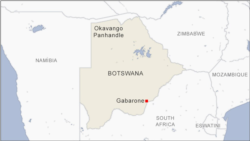The mystery surrounding a mass die-off of elephants in Botswana is deepening after initial test results ruled out poisoning and anthrax.
Wildlife officials had earlier ruled out poaching as no ivory had been taken. But officers have discovered more carcasses as the death toll surpasses 100.
Samples would now be sent to neighboring South Africa for further tests.
Wildlife officer Dikamatso Ntshebe said more animals could die, as some look sickly.
“We are still experiencing elephants dying in the Okavango Panhandle,” Ntshebe said. “We also see elephants that show that they are sick and are on the verge of dying. As of Friday, we had a total count of 110 elephant carcasses.”
Villagers have been warned against consuming meat from the dead animals.
Ntshebe said the public has thus far heeded the call.
The Department of Wildlife has begun removing tusks from the carcasses.
“We have started removing the tusks in the dead elephants, and we have started burning the carcasses.” Ntshebe said. “We have started with those (carcasses), which are close to the villages, and those that are lying in the water. The idea is to burn as many carcasses as possible. However, we have a challenge since some of the carcasses are in areas which are difficult to reach.”
The department is also investigating the cause of the elephant deaths. The search is complicated by the COVID-19 crisis, which may delay results from the samples. The COVID-19 disease is caused by the coronavirus.
Botswana has the world’s largest elephant population, at more than 130,000.









